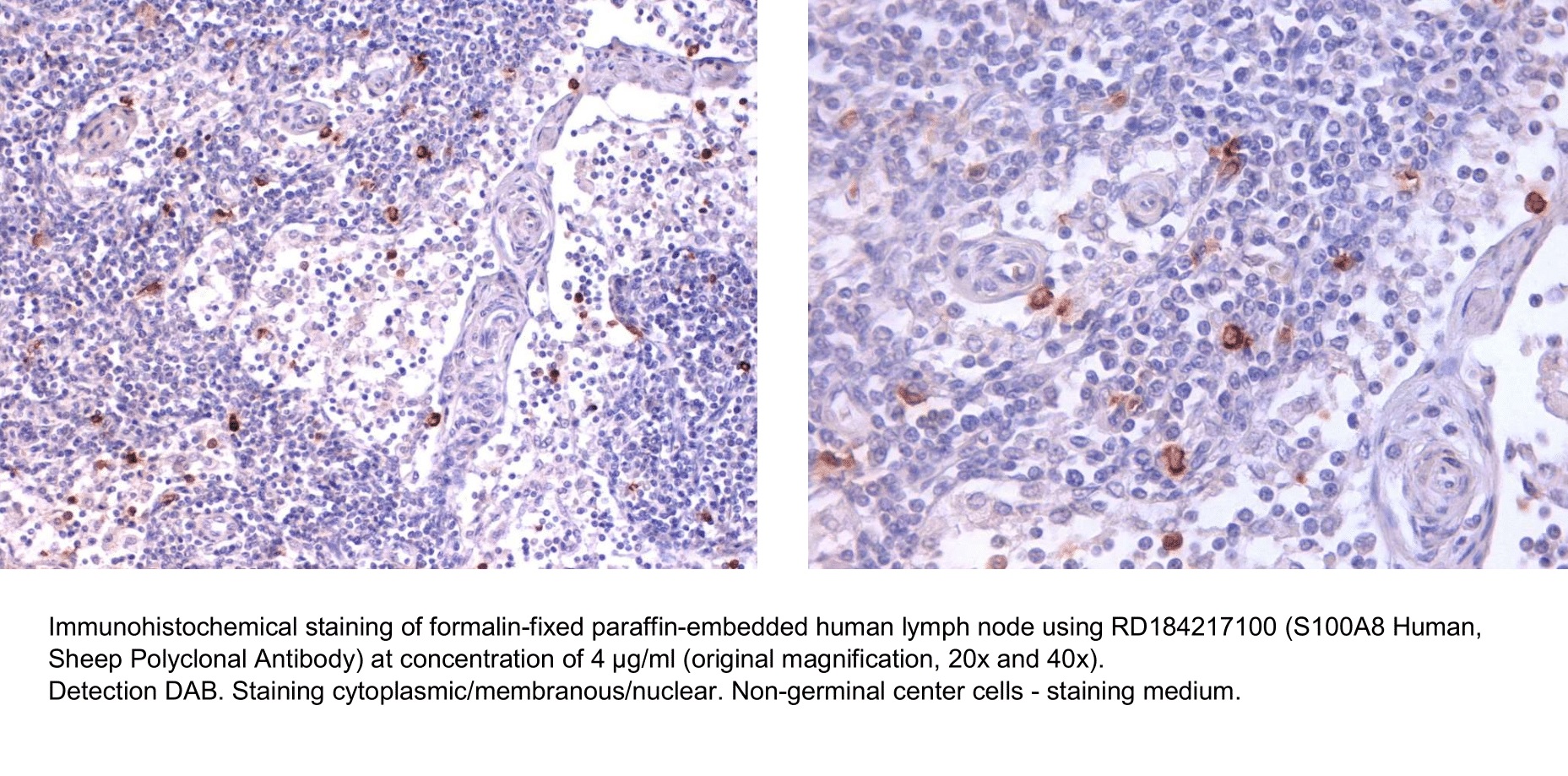Type
Polyclonal Antibody
Applications
Western blotting, Immunohistochemistry
Antibodies Applications
Source of Antigen
E. coli
Hosts
Sheep
Isotype
IgG
Preparation
The antibody was raised in sheep by immunization with the recombinant Human S100A8.
Amino Acid Sequence
Recombinant Human S100A8, total 103 AA. MW: 12.08 kDa (calculated). UniProtKB acc.no. P05109. N-Terminal His-tag, 10 extra AA.
MKHHHHHHASMLTELEKALNSIIDVYHKYSLIKGNFHAVYRDDLKKLLETECPQYIRKKGADVWFKELDINTDGAVNFQEFLILVIKMGVAAHKKSHEESHKE
Species Reactivity
Human. Not yet tested in other species.
Purification Method
Immunoaffinity chromatography on a column with immobilized recombinant Human S100A8.
Antibody Content
0.1 mg (determined by BCA method, BSA was used as a standard)
Formulation
The antibody is lyophilized in 0.05 M phosphate buffer, 0.1 M NaCl, pH 7.2.
Reconstitution
Add 0.2 ml of deionized water and let the lyophilized pellet dissolve completely. Slight turbidity may occur after reconstitution, which does not affect activity of the antibody. In this case clarify the solution by centrifugation.
Shipping
At ambient temperature. Upon receipt, store the product at the temperature recommended below.
Storage/Expiration
The lyophilized antibody remains stable and fully active until the expiry date when stored at -20°C. Aliquot the product after reconstitution to avoid repeated freezing/thawing cycles and store frozen at -80°C. Reconstituted antibody can be stored at 4°C for a limited period of time; it does not show decline in activity after one week at 4°C.
Quality Control Test
Indirect ELISA – to determine titer of the antibody
SDS PAGE – to determine purity of the antibody
BCA - to determine quantity of the antibody
Note
This product is for research use only.
Research topic
Immune Response, Infection and Inflammation, Oncology, Pulmonary diseases, Sepsis
Summary
S100A8 and S100A9 belong to a family of 25 homologous low-molecular-weight intracellular calcium-binding proteins that exhibit tissue and cell-specific expression. They are characterized by two distinct EF-hand (helix-loop-helix) calcium-binding domains connected by a hinge region. The N-terminal Ca2+ binding domain has lower affinity than the canonical C-terminal domain that allows for functionally important second messenger roles dependent on intracellular Ca2+ levels. Human S100A8 (also known as MRP8, calgranulin A, L1 light chain, cystic fibrosis antigen) is the most closely related member of the human (h) S100 family to mS100A8, although the level of homology is low (69% at the DNA level; 58% at the amino acid level). Human S100A8 is a calcium-binding protein member of the S100 protein family, is highly expressed in the cytosol of neutrophils and monocytes, and is frequently found at high levels in the extracellular milieu during inflammatory conditions. S100A8 is almost exclusively expressed by cells of myeloid lineage and is constitutively expressed in the cytosol of neutrophils. Monocytes and differentiated macrophages from inflamed tissues also express S100A8. Increased serum levels of the S100A8 (MRP-8) protein have been reported in inflammatory conditions including bacterial infection, arthritis, and cystic fibrosis (CF). Preferentially exists as a heterodimer or heterotetramer with S100A9 known as calprotectin (S100A8/A9). Calprotectin (S100A8/9) is predominantly expressed in myeloid cells. Except for inflammatory conditions, the expression is restricted to a specific stage of myeloid differentiation since both proteins are expressed in circulating neutrophils and monocytes but are absent in normal tissue macrophages and lymphocytes. Under chronic inflammatory conditions, such as psoriasis and malignant disorders, also expressed in the epidermis. Found in high concentrations at local sites of inflammation or in the serum of patients with inflammatory diseases such as rheumatoid, cystic fibrosis, inflammatory bowel disease, Crohn's disease, giant cell arteritis, cystic fibrosis, Sjogren's syndrome, systemic lupus erythematosus, and progressive systemic sclerosis. Involved in the formation and deposition of amyloids in the aging prostate known as corpora amylacea inclusions. Strongly up-regulated in many tumors, including gastric, esophageal, colon, pancreatic, bladder, ovarian, thyroid, breast and skin cancers.

